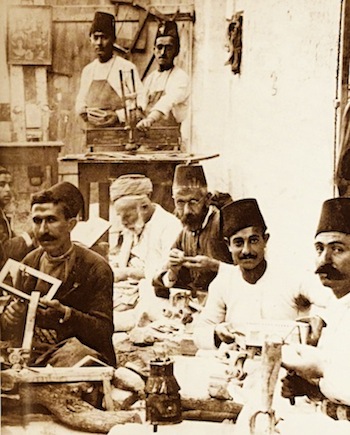History of Olive Wood Handicrafts In Bethlehem Starts Among the most important economic activities in Bethlehem are local handicraft products made from olive wood, mother of pearl and coral.
The history of these handicrafts is directly linked to that of the Franciscan brotherhood in Bethlehem, which starting in the sixteenth century set up special centers for teaching the art of intaglio and working with mother of pearl, and encouraged the opening of artisan workshops dedicated to these techniques, in order to produce liturgical furnishings, creches and other handmade articles.
The economic well-being of many Bethlehem families still depends today on these activities, even more so after the construction of the wall that has partially isolated the people living in these areas. The first testimony referring to the use of these techniques dates from 1586 when the Belgian pilgrim Jean Zuallart (known also as Giovanni di Zuallardo), describing his pilgrimage to the Holy Places, said this about Bethlehem:“They make crowns and small crosses from olive, cedar and other woods” (Il devotissimo viaggio di Gerusalemme, Roma 1595, p. 206).
The teaching of these techniques can be traced back to the establishment of a school in 1347 where, in addition to studies of theoretical subjects, instruction in practical disciplines and handicrafts was also promoted. From this breeding ground of artisans, manufacture began not only of simple materials but also of objects of great art and value, notably models of the Holy Places and crèches in mother-of-pearl and olive wood.
These made use of the studies on perspective carried out by Bernardino Amico, who was in Bethlehem between 1593 and 1597, leading to the production of models that were true masterpieces, especially those in mother of pearl.
Under the Ottoman Empire, the production of local handicrafts came to a halt due to the reduction in the number of pilgrims. Only at the beginning of the 20th century did production recover, due in large part to the contribution of Father Pacifico Riga who, during his 24 years as director and design teacher at the Bethlehem school, rediscovered and promoted the teaching of these skills.
About 85% of Bethlehem People they make their living in this storied craft. These skills have been kept in the family and passed through the generations, father to son. We start with the highest quality olive wood, which is trimmed and dried for years to ensure its durability and beauty. This blessed wood comes from the olive groves in Bethlehem’s countryside. While carving technology has advanced over the years, we have maintained the highest standards of our hand carving.

